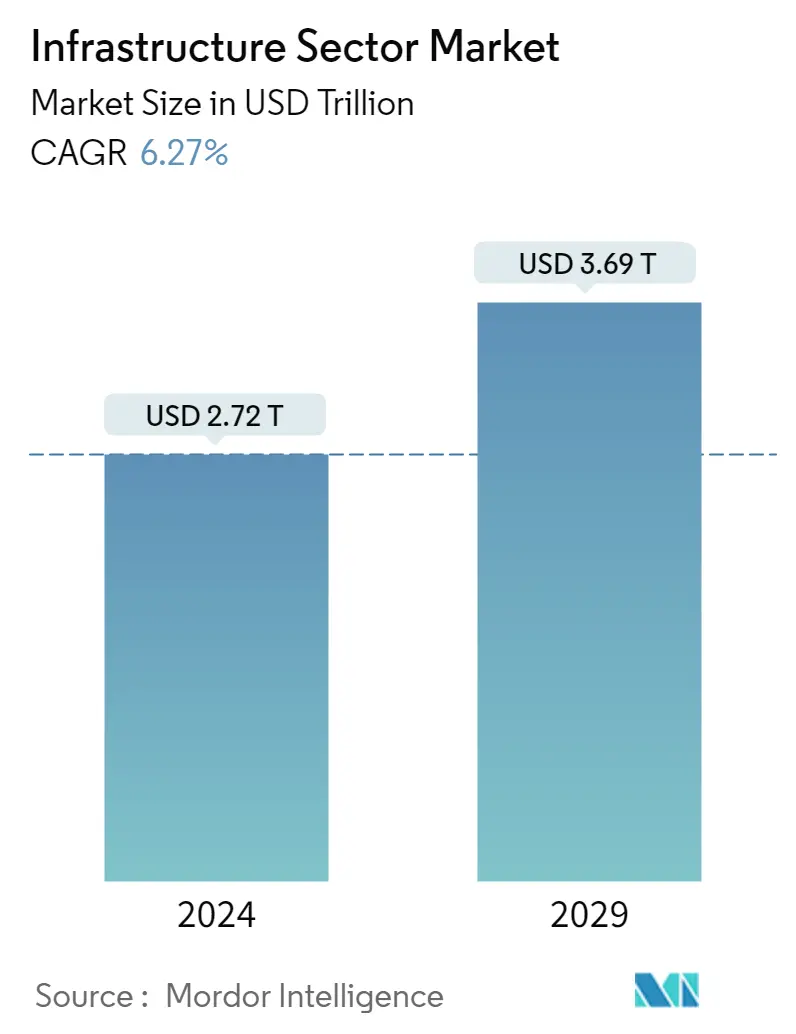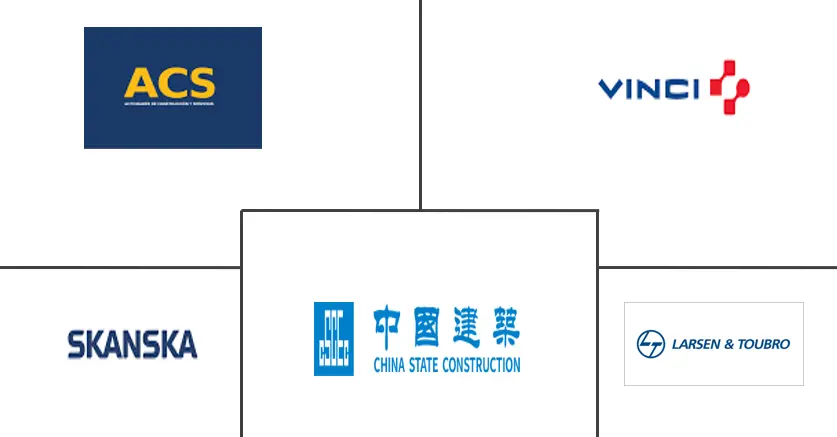Market Size of Infrastructure Sector Industry

| Study Period | 2020 - 2029 |
| Market Size (2024) | USD 2.72 Trillion |
| Market Size (2029) | USD 3.69 Trillion |
| CAGR (2024 - 2029) | 6.27 % |
| Fastest Growing Market | North America |
| Largest Market | Asia-Pacific |
Major Players
*Disclaimer: Major Players sorted in no particular order |
Infrastructure Construction Market Analysis
The Infrastructure Sector Market size is estimated at USD 2.72 trillion in 2024, and is expected to reach USD 3.69 trillion by 2029, growing at a CAGR of 6.27% during the forecast period (2024-2029).
- COVID-19 had a negative impact on national economies and the economic livelihood of governments, businesses, and individuals. But significantly lower usage rates in infrastructure during the pandemic and the resulting shortfall in financing and maintenance received the attention of local and national governments, which focused on allocating financial resources to meet the immediate needs of healthcare and supply chains during the pandemic. COVID-19 caused a demand and supply shock that resulted in construction interruptions or delays due to a lack of personnel, supply chain disruptions, or delays in government approvals throughout the world. In many sectors, assets dependent on user fees faced a dramatic decrease in demand, resulting in substantial revenue losses for project sponsors. This increased project risks, such as default events, termination, insolvency, or governments breaching contracts.
- Although heavily impacted by the disruptions caused by the COVID-19 pandemic, the global infrastructure construction output still expanded in 2020, as governments around the world sought to stimulate economic activity through investments in transport infrastructure and clean energy.
- Ultimately, the global shift to sustainable infrastructure requires interventions and collaborative action from multiple participants. The interventions include not just public-private cooperation and consolidated effort but also new ways of measuring the impact and developing innovative instruments geared to financing green infrastructure projects. Factors important at a national and regional level include regulatory frameworks, subsidies, and tax regimes. These overlapping considerations mean that funding and building sustainable infrastructure is arguably one of the biggest and most complex challenges the global financial and political system has ever faced. But it is a challenge that must be overcome.
- Infrastructure is relatively underinvested in advanced technologies compared to other capital-intensive industries. In the current environment, pressure due to capacity reduction and the rising costs may encourage asset owners and project managers to accelerate the adoption of technologies such as artificial intelligence and robotics. There is also an opportunity to reduce maintenance capital expenses using technologies such as intelligent drones. These drones lessen the need for onsite workers, thus increasing safety. They can dramatically improve preventative maintenance, inspecting, and scoping. They work faster than existing methods and provide more detailed information about required repairs.
- More broadly, the shift to remote working arrangements across many industries has underlined the growing need for secure, resilient, cloud-based technologies, and connective infrastructure. Growing usage of cloud technology is expected to boost the demand for data transmission and storage assets including fiber networks, data, edge datacentres, and telecommunication towers that are already popular among infrastructure investors.
Infrastructure Construction Industry Segmentation
Infrastructure construction is a proposed plan to build, maintain, and upkeep infrastructural facilities, systems, and services. Building new roads, constructing new power plants, maintaining sewage systems, and providing drinking water to the public are all examples of infrastructure construction.
The study is a comprehensive background analysis of the infrastructure construction market, covering the current market trends, restraints, technological updates, and detailed information on various segments and the competitive landscape of the industry. The impact of COVID-19 has also been incorporated and considered during the study.
The Global Infrastructure Construction Market is segmented by Type (Social Infrastructure (Schools, Hospitals, Defense, Other Infrastructure), Transportation Infrastructure (Railways, Roadways, Airports, Ports, Waterways), Extraction Infrastructure (Oil and Gas, Other Extraction (Minerals, Metals, and Coal), Utilities Infrastructure (Power Generation, Electricity Transmission & Distribution, Water, Gas, Telecoms), Manufacturing Infrastructure (Metal and Ore Production, Petroleum Refining, Chemical Manufacturing, Industrial Parks and Clusters, and Other Infrastructure)) and by Geography (North America, Europe, Asia-Pacific, Latin America, Middle East, and Africa). The report offers market size and forecasts for the Global Infrastructure Construction Market in value (USD) for all the above segments.
| By Type | |||||||
| |||||||
| |||||||
| |||||||
| |||||||
|
| By Geography | |
| North America | |
| Europe | |
| Asia-Pacific | |
| Latin America | |
| Middle East & Africa |
Infrastructure Sector Market Size Summary
The infrastructure sector is poised for significant growth over the coming years, driven by a combination of government stimulus measures and the urgent need for sustainable development. The sector, which encompasses a wide range of activities including transport infrastructure, clean energy projects, and urban development, is expected to see substantial investments as countries aim to recover from the economic impacts of the COVID-19 pandemic. The pandemic highlighted the vulnerabilities in infrastructure systems, leading to increased focus on resilient and sustainable solutions. Governments worldwide are prioritizing infrastructure as a key component of their economic recovery plans, with a particular emphasis on public-private partnerships and innovative financing mechanisms to support green projects. This shift is further supported by advancements in technology, such as artificial intelligence and robotics, which are being integrated to enhance efficiency and reduce costs in infrastructure development and maintenance.
The global infrastructure market is characterized by its fragmented and competitive nature, with numerous domestic and international players contributing to its growth. Major companies such as ACS Group, VINCI, and China State Construction Engineering Corp. Ltd are leading the charge in various regions, particularly in Europe and Asia. The demand for infrastructure is being fueled by rapid urbanization, increased freight service needs, and the expansion of cloud-based technologies, which require robust data transmission and storage networks. In regions like Asia-Pacific, foreign direct investment remains strong, underscoring the area's attractiveness to investors. Despite challenges such as bureaucratic delays and regulatory hurdles, countries like India and the Philippines are making concerted efforts to streamline processes and boost infrastructure spending, aiming to enhance their economic competitiveness and support long-term growth.
Infrastructure Sector Market Size - Table of Contents
-
1. MARKET INSIGHTS AND DYNAMICS
-
1.1 Industry Outlook (Current Economic and Construction Market Scenario)
-
1.1.1 GDP, Fiscal Policy, Monetary Policy, Economic Activity
-
1.1.2 Inflation
-
1.1.3 Interest Rates
-
1.1.4 Exchange Rates
-
1.1.5 Consumer Confidence
-
1.1.6 Infrastructure Spending
-
1.1.7 Development Indices Ranking
-
-
1.2 Regulatory Environment, Compliance Processes, EHS Trends and Key Policy Initiatives for the Global Infrastructure Sector
-
1.3 Technological Innovations in the Construction Sector
-
1.4 Market Dynamics
-
1.4.1 Drivers
-
1.4.2 Restraints
-
1.4.3 Opportunities
-
1.4.4 Porter's Five Forces Analysis
-
1.4.5 Industry Value Chain Analysis
-
-
1.5 Impact of COVID - 19 on the Market
-
-
2. MARKET SEGMENTATION (Market Size By Value)
-
2.1 By Type
-
2.1.1 Social Infrastructure
-
2.1.1.1 Schools
-
2.1.1.2 Hospitals
-
2.1.1.3 Defense
-
2.1.1.4 Other Infrastructure
-
-
2.1.2 Transportation Infrastructure
-
2.1.2.1 Railways
-
2.1.2.2 Roadways
-
2.1.2.3 Airports
-
2.1.2.4 Ports
-
2.1.2.5 Waterways
-
-
2.1.3 Extraction Infrastructure
-
2.1.3.1 Oil and Gas
-
2.1.3.2 Other Extraction (Minerals, Metals, and Coal)
-
-
2.1.4 Utilities Infrastructure
-
2.1.4.1 Power Generation
-
2.1.4.2 Electricity Transmission & Distribution
-
2.1.4.3 Water
-
2.1.4.4 Gas
-
2.1.4.5 Telecoms
-
-
2.1.5 Manufacturing Infrastructure
-
2.1.5.1 Metal and Ore Production
-
2.1.5.2 Petroleum Refining
-
2.1.5.3 Chemical Manufacturing
-
2.1.5.4 Industrial Parks and Clusters
-
2.1.5.5 Other Infrastructure
-
-
-
2.2 By Geography
-
2.2.1 North America
-
2.2.2 Europe
-
2.2.3 Asia-Pacific
-
2.2.4 Latin America
-
2.2.5 Middle East & Africa
-
-
Infrastructure Sector Market Size FAQs
How big is the Infrastructure Sector Market?
The Infrastructure Sector Market size is expected to reach USD 2.72 trillion in 2024 and grow at a CAGR of 6.27% to reach USD 3.69 trillion by 2029.
What is the current Infrastructure Sector Market size?
In 2024, the Infrastructure Sector Market size is expected to reach USD 2.72 trillion.

